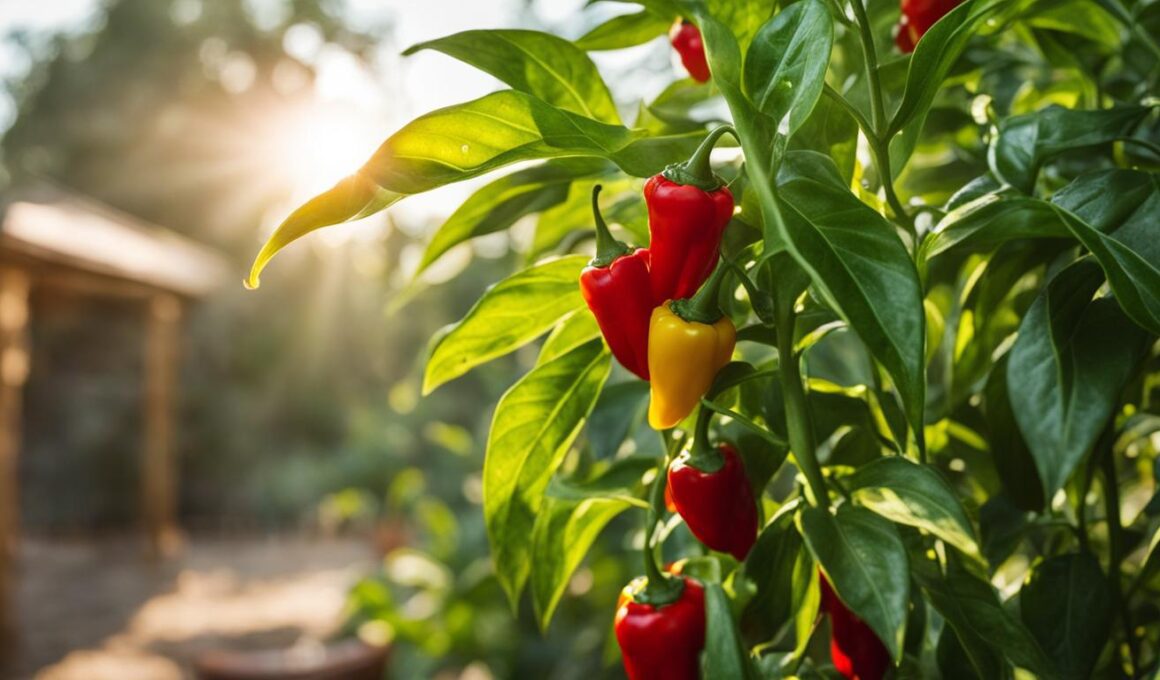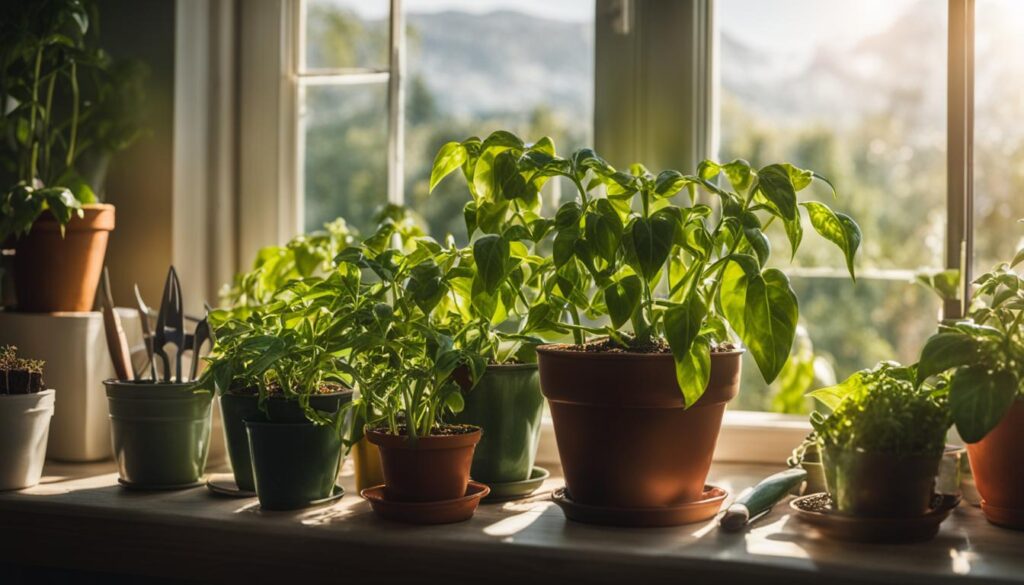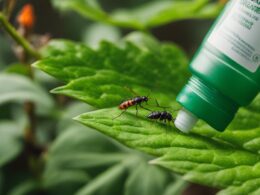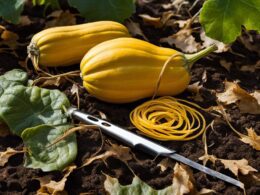Peppers, known for their vibrant colors and spicy flavors, thrive in the warmth of the sun. But what if you have limited gardening space or a shady area? Can peppers still grow in indirect sunlight? Let’s find out.
In order to produce bountiful harvests, peppers require strong light. Ideally, they should be planted in a location that receives 6-12 hours of direct sunlight daily. However, peppers can survive in partial shade, although growing them in full shade is not recommended as it can lead to smaller plants and poor yields.
The transition from indoor grow lights to sunlight should be done slowly through a process called hardening off. This gradual exposure to direct sunlight helps the plants acclimate and prevents sun scald, which is essentially a sunburn for the plants. It’s important to note that peppers grown in a sunny window may also require additional light when grown in containers or indoors.
Reflective materials can be used to increase the amount of light peppers receive. These materials redirect sunlight to the plants, helping them thrive even in areas with limited direct sunlight.
While peppers can grow in indirect sunlight, it’s important to provide them with optimal light conditions for better growth and larger harvests. Let’s explore the factors that influence their sunlight requirements and the best practices to ensure their success.
Post Summary
- Peppers need strong light to grow best and should receive 6-12 hours of direct sunlight daily.
- Growing peppers in full shade is not recommended as it can lead to smaller plants and poor yields.
- The transition from indoor grow lights to sunlight should be gradual through the hardening off process.
- Peppers can suffer from sun scald if not properly acclimated to direct sunlight.
- Reflective materials can be used to increase the amount of light peppers receive.
How Much Sun Do Peppers Need?
Peppers require strong light to grow their best and produce bountiful harvests. The amount of sunlight they need is crucial for their growth and fruit production. Ideally, peppers should be planted in a location that receives 6-12 hours of direct sunlight daily. This strong light provides the energy needed for photosynthesis, which is essential for plant growth and the development of healthy fruits.
When it comes to sunlight exposure, morning sun is prioritized over afternoon light. This is because the sun’s rays are not as intense in the morning, reducing the risk of sun scald, which is essentially a sunburn for the plants. By avoiding the most intense time of day for direct sunlight, peppers can thrive without the risk of damage.
While peppers can survive with 6 or fewer hours of sunlight, it’s important to note that this may result in smaller harvests. Providing them with the recommended 6-12 hours of direct sunlight ensures optimal growth and fruit production, leading to more abundant harvests.
| Amount of Sunlight | Impact on Peppers |
|---|---|
| 6 or fewer hours | Smaller harvests |
| 6-12 hours | Optimal growth and fruit production |
Can Peppers Plants Grow in the Shade?
While peppers prefer plenty of direct sunshine, they can still be grown in partial shade if your gardening space is limited. However, growing peppers in full shade is not recommended as it can have negative effects on their growth and yield. When peppers are grown in shade, they tend to develop into smaller plants with poor yields. This is because they receive less sunlight, which is essential for providing the energy needed for photosynthesis and plant growth.
In addition to limited sunlight, growing peppers in shade can also lead to other challenges. The availability of water, soil aeration, and drainage may be compromised in shady areas, resulting in slower transpiration and poor nutrient uptake. With reduced sunlight and limited access to essential resources, peppers in the shade may exhibit slower growth and smaller harvests. Additionally, the lack of energy from sunlight can make pepper plants unhappy and more susceptible to pests and diseases.
To ensure the best chance of success when growing peppers in shade, it’s important to provide optimal growing conditions wherever possible. This includes selecting a location that offers the most direct sunshine available in your gardening space. If you have areas with more direct sunlight, consider planting peppers there instead. By providing peppers with the sunlight they require, you can help promote healthier growth, improved yields, and happier pepper plants.
The Effects of Shade on Pepper Plants
When peppers are grown in the shade, they experience several challenges that can hinder their growth and development. These include:
- Smaller plants: Peppers grown in shade tend to be smaller in size compared to those grown in full sun.
- Poor yields: The lack of sunlight can result in reduced fruit production, leading to poor yields.
- Water and nutrient uptake: Shady areas may have poor soil aeration and drainage, which can inhibit the plant’s ability to uptake water and nutrients.
- Slower transpiration: With less sunlight, transpiration, the process by which plants release water vapor through their leaves, can be slower in pepper plants grown in shade.
- Lack of energy: Sunlight provides the energy needed for photosynthesis, the process by which plants convert sunlight into food. Peppers in the shade may not receive enough energy, leading to slower growth and poor overall plant health.
In conclusion, while peppers can be grown in partial shade, it is important to consider the limitations and challenges that come with it. Providing optimal sunlight to your peppers will ensure better growth, larger harvests, and healthier plants overall. If you have limited gardening space with shade, it may be worth exploring other options or finding creative solutions to maximize the sunlight available to your pepper plants.
Transitioning Peppers from Indoors to Sunlight
Transitioning your pepper plants from indoors to direct sunlight is a crucial step in their growth journey. By following a gradual and careful process called hardening off, you can ensure that your plants acclimate to the outdoors and thrive under the energy of the sun. Rushing this transition can harm your plants and hinder their growth, so it’s important to take it slowly and give them time to adjust.
To begin the hardening off process, start by exposing your pepper plants to a few minutes of direct sunlight each day. Place them in a location where they will receive gentle morning sun, gradually increasing the time they spend outside over the course of 2-3 weeks. This gradual exposure to sunlight will help the plants develop a tolerance to the strong rays and prevent sun scald, which can damage their new foliage.
During this transition, it’s essential to monitor your plants closely. Keep an eye out for any signs of stress, such as wilting or leaf discoloration, and adjust the amount of sunlight they receive accordingly. If the plants show signs of distress, reduce their exposure to direct sunlight and gradually increase it again once they have recovered. This process requires patience and attentiveness, but it will ultimately result in healthier and stronger pepper plants.
| Transitioning Peppers from Indoors to Sunlight | Tips for Successful Transition |
|---|---|
| Start with a few minutes of direct sunlight per day | Gradually increase the time spent outside over 2-3 weeks |
| Monitor plants for signs of stress | Adjust sunlight exposure based on plant’s response |
| Protect plants from strong winds and extreme temperatures | Provide shade if necessary during the transition period |
“The hardening off process is vital for transitioning pepper plants from controlled indoor conditions to the outdoor environment. Taking the time to gradually expose them to direct sunlight will ensure their successful adaptation and minimize the risk of sun scald.” – Gardening Expert
Remember to protect your plants from harsh weather conditions during the transition. Strong winds and extreme temperatures can put stress on them, so it’s important to provide some shelter when necessary. This can be done by placing your pepper plants in a protected area or using shade cloth to filter the sunlight. By creating a favorable environment, you give your plants the best chance to thrive.
Transitioning peppers from indoors to sunlight is a crucial step in their growth journey. By following the hardening off process and providing gradual exposure to direct sunlight, you can ensure the successful transition of your plants. Be patient, monitor their progress, and protect them from harsh conditions, and you’ll soon be rewarded with healthy and productive pepper plants.
Conclusion
Peppers are a versatile plant that can grow in a variety of conditions, but they thrive best in direct sunlight. Ideally, peppers should be planted in a location that receives 6-12 hours of direct sunlight each day. This ensures that they receive the necessary energy to grow and produce bountiful harvests.
While peppers can tolerate some shade, it is not recommended to grow them in full shade as it can result in smaller plants and poor yields. Partial shade may be suitable, but be aware that it can lead to slower growth and smaller harvests due to the lack of available energy for photosynthesis.
When transitioning peppers from indoors to sunlight, it is important to follow a gradual process called hardening off. This involves slowly exposing the plants to increasing periods of direct sunlight each day over a span of 2-3 weeks. Rushing this process can cause sun scald, which can harm the plants. By gradually acclimating them, the peppers will be able to handle direct sunlight without any damage.
In conclusion, providing peppers with optimal sunlight is essential for their growth and productivity. While they can tolerate some shade and can be transitioned from indoors to direct sunlight, ensuring they receive the right amount of light and energy will result in healthier plants and larger harvests.
FAQ
Can peppers grow in indirect sunlight?
Peppers can grow in indirect sunlight, but they may require even more light when grown in containers or indoors.
How much sun do peppers need?
Peppers need strong light and should be planted in a location that receives 6-12 hours of direct sunlight daily. Morning sun is prioritized over afternoon light.
Can pepper plants grow in the shade?
Peppers can survive in partial shade, but growing them in full shade is not recommended as it can lead to smaller plants and poor yields.
How do you transition peppers from indoors to sunlight?
Transition peppers gradually through a process called hardening off, exposing them to a few minutes of direct sunlight per day and gradually increasing the time over 2-3 weeks.
What are the advantages of growing peppers in the shade?
Growing peppers in the shade can reduce heat stress and water evaporation, but it may also lead to reduced fruit production, increased risk of diseases, and slower growth.
Will Lettuce and Peppers Thrive in Similar Growing Conditions?
When considering the growing lettuce indoors light requirements, it’s important to note that both lettuce and peppers thrive in similar conditions. Both plants prefer well-draining soil, adequate sunlight, and consistent watering. With the right care and attention to their specific needs, you can successfully grow both lettuce and peppers indoors.











